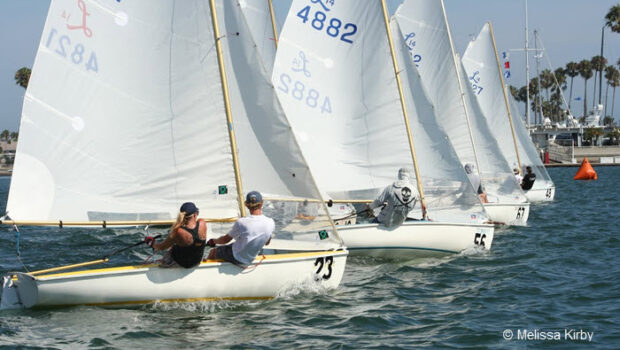The Dynamics of Sailing Maneuvers
Sailing offers a myriad of techniques that sailors continually refine. One crucial aspect of sail dynamics is the maneuver known as tacking. This is where a boat sails a zigzag course towards its destination by turning its bow into the wind, shifting the sails to harness varying wind directions. Recent studies have shed light on the intricacies involved in this basic yet vital maneuver.
The Science Behind Tacking
Universities like the University of Michigan and New York University have undertaken intensive research into the physics of tacking. They aim to enhance our understanding of the fluid-structure interactions that occur when a sailboat is maneuvering from one tack to another. The dynamics involved can be complex, involving the wind’s force and the sails’ movement, which can often feel chaotic.
As one researcher put it, “There has been much exploration into optimizing sail shapes and hull forms, yet the interactions of these elements during unsteady maneuvers warrant deeper investigation.” This approach highlights the importance of simplifying complex models to better grasp how boats respond to winds during tactics that sailors execute regularly.
Unsteady Maneuvers: More Than Just Tacking
While tacking is a significant focus, it’s important to recognize that sailing involves a broader repertoire of maneuvers. From gybing to reaching, each maneuver has its unique challenges and physics. Understanding these dynamics can greatly enhance sailing performance, making it crucial for aspiring sailors to study not just the theory but also the practical aspects of sailing.
The Role of Sail Design
Optimizing sail design plays an integral role in how effectively these maneuvers are executed. Sailors need to appreciate how the shape and material of the sails can substantially affect performance. A well-designed sail allows for better wind uptake, ensuring that every tack or gybe maximizes speed and maneuverability.
Practical Implications for Sailing Rentals
At GetBoat, keeping an eye on these developments enriches the sailing experience for clients. Whether for a leisurely trip or a competitive sailing endeavor, understanding the nuances of maneuvers like tacking can make a noticeable difference on the water. The program not only offers a multitude of vessels tailored to different tastes and budgets, but it also empowers sailors with the knowledge they need to navigate efficiently.
Historical Context of Sailing Maneuvers
Sailing has evolved significantly over the centuries. The beginnings of modern sailing techniques are rooted in the historical advancements of sail and boat design. From early maritime voyages to contemporary competitive sailing, the essence of navigation has been shaped by both technology and human skill.
Additionally, the rise of one-design classes emphasizes the importance of mastering techniques like tacking. In these classes, all boats are built to the same specifications, allowing sailors to focus on skill and strategy rather than equipment differences. This initiative has made racing more equitable and highlighted the importance of proficiency in sailing maneuvers.
Concluding Thoughts on Sailing Dynamics
Understanding the dynamics behind maneuvers in sailing, especially tacking, is not just an academic pursuit; it profoundly impacts how chartering and rentals operate. Sailors can enjoy greater freedom and energy on the water, expanding the possibilities for adventure.
At GetBoat.com, we appreciate the unique thrill of sailing and the charm of coastal vacations. Our service emphasizes the freedom to choose your course, aligning perfectly with the thrill of sailing adventures. Clients can navigate through various options to find the ideal boat, yacht, or sailboat that fits their style, from luxury yachts to simple sailing boats.
Highlights of Dynamic Adjustments in Sailing
Engagement with sailing goes beyond learning about the boats and their designs; it encompasses the spirit of adventure that comes with exploring new waters. As each inlet, bay, and lagoon presents distinct characters, so do they reflect the rhythm of local life, culture, and cuisine.
Why Renting a Boat Enhances Your Experience
- Learns about the rich history and culture of sailing.
- Gains insights into the capabilities of different sailing techniques.
- Explores various picturesque locations from the unique perspective of the water.
- Has an opportunity to engage with the spirit of adventure.
If you are planning your next trip to the sea, renting a boat is an excellent way to see distinctive features that each area has to offer, similar to discovering the local food and architecture. A well-chosen vessel provides both comfort and an avenue to learn about the local setting as you navigate the waters【4:0†source】. At GetBoat, we recognize that every adventure on the water is a unique experience, making GetBoat.com the go-to choice for unforgettable nautical journeys.
Forecasting the Future of Sailing Adventures
With ongoing research into the dynamics of tacking and sail behavior, the significance of sailing maneuvers is becoming increasingly pivotal in the world of sailing. These insights promise to impact global tourism and boating experiences positively. Thus, GetBoat is committed to staying ahead of the curve, keeping pace with evolving developments to offer seamless sailing rentals. Start planning your next seaside adventure and secure your sailing experience with GetBoat before opportunities sail away!
Wrap-Up
The exploration of tacking dynamics and other maneuver techniques is essential in enhancing sailing experiences. By providing a deeper understanding, GetBoat.com ensures that clients access a global solution for unforgettable adventures, including renting or purchasing boats and yachts. With transparent details about vessels available, it promotes informed choices for a perfect getaway at sea.


